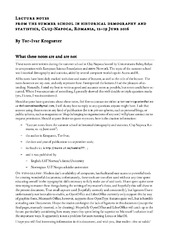Between Heaven and Hell: The role of the clergy in the witchcraft prosecutions in Finnmark, 1620-1692
Permanent lenke
https://hdl.handle.net/10037/25276Dato
2020-05-25Type
MastergradsoppgaveMaster thesis
Forfatter
Hegsvold Sørlie, HaakonSammendrag
This dissertation investigates the role of the clergymen in Finnmark in the witchcraft prosecutions that took place in the region from 1620–1692. The dissertation builds on a large amount of primary evidence from both judicial and ecclesiastical archives. The topic is approached through a qualitative critical contextual reading of the sources, this strong basis in the sources enables an investigation into the role of the clergy both inside and outside of the prosecutions. The dissertation argues that the clergy had two roles, one was clearly religious and was concerned with the salvation of the sentenced person’s soul. The other was of a more secular nature and was concerned with interrogating and questioning of the accused, but both these roles experienced development and nuance throughout the period. These two roles were not fulfilled by all the clergymen, as the study has found that there was a somewhat frequent deviation between normative regulation and praxis among the clergymen in Finnmark. This difference between norm and praxis is also evident in the clergy’s role in the prosecutions, as this dissertation nuances the established view that the clergymen acted as a united group in demonizing popular culture. The study has found that only a minority of the clergymen in Finnmark had attended university in the seventeenth century, this resulted in a hybrid understanding of witchcraft among the clergymen that accepted elements of both diabolism and maleficium. In addition, the clergy had a heterogenous approach to witchcraft, some clergymen never prosecuted rumoured witches, others gave impetus to the trials, and some attempted to punish the witches through alternative methods such as church discipline. The argument that the clergymen involved themselves in the trials in their role as state officials is also nuanced, although the self-regulatory relationship between priest and parishioners disappeared during the prosecutions, there is clear evidence that some clergymen had personal incentives when they involved themselves in the prosecutions.
Forlag
UiT Norges arktiske universitetUiT The Arctic University of Norway
Metadata
Vis full innførselSamlinger
Copyright 2020 The Author(s)
Følgende lisensfil er knyttet til denne innførselen:
Med mindre det står noe annet, er denne innførselens lisens beskrevet som Attribution-NonCommercial-ShareAlike 4.0 International (CC BY-NC-SA 4.0)
Relaterte innførsler
Viser innførsler relatert til tittel, forfatter og emneord.
-
Lecture notes from the summer school in historical demography and statistics, Cluj-Napoca, Romania, 12–19 June 2016
Krogsæter, Tor-Ivar (Lecture; Forelesning, 2016-06-19) -
Folkemordet i Rwanda - Voldens brutalitet og sivile aktørers deltagelse
Kolstad, Charlotte Renland (Master thesis; Mastergradsoppgave, 2014-05-15)I 1994 ble rundt 800 000 mennesker drept i et lite sentralafrikansk land, størrelsen på landet kan sammenlignes med Troms fylke i Norge. Hendelsen er kjent som folkemordet i Rwanda. I senere tid har det blitt utgitt et relativt bredt spekter av litteratur på feltet, hvor forskere har hatt forskjellige ståsteder som har resultert i ulike synsvinklinger. Prosjektet tar for seg sentrale oppfatninger ... -
Kvinner i sovjetisk og russisk krigsfilm - offer og moralske førebilete
Høgetveit, Åsne Øysteinsdotter (Master thesis; Mastergradsoppgave, 2014-05-16)Oppgåva undersøker korleis kvinnelege soldatar vert framstilt i filmane A zori zdes’ tikhie (Rostotskij 1972) og Leningrad (Buravskij 2007). Om lag ein million kvinner tenestegjorde i dei sovjetiske styrkane under andre verdskrigen. Kvinners krigsdeltaking gjekk langt utover dei tradisjonelle kvinneoppgåvene som helsepersonell og innom administrasjon: Kvinnelege soldatar var skarpskyttarar, pilotar, ...


 English
English norsk
norsk



